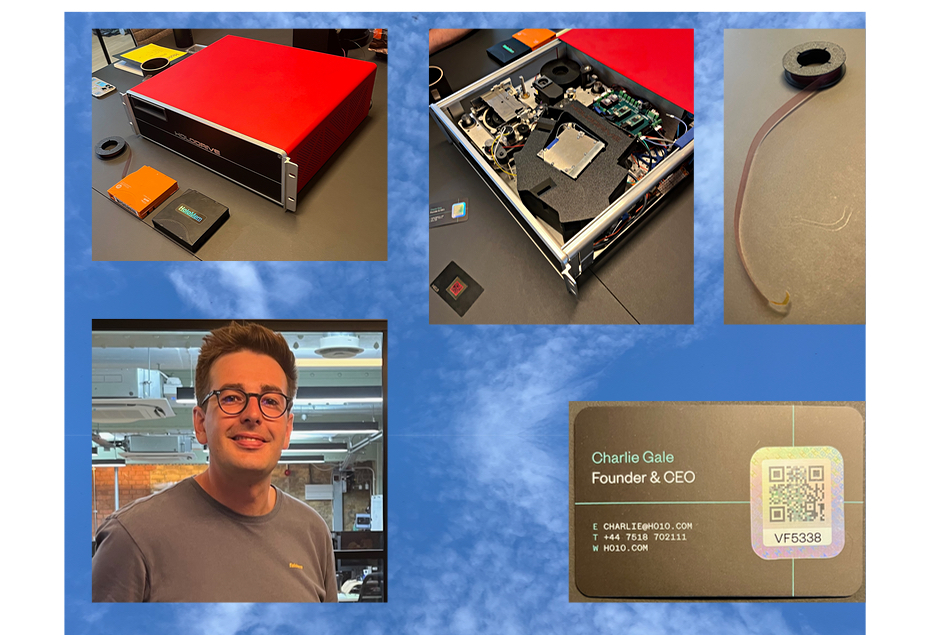UK startup HoloMem is developing a ribbon-based cartridge and drive that uses multi-layer holographic storage with a 50+ year life span, and can be inserted as a rack shelf in LTO libraries with no change needed to upstream software.
Unlike previous holographic storage startups, the HoloMem technology uses off-the-shelf components, like a $5 laser diode, and mass-produced polymer sheets to make a robust and affordable drive and chassis with no high-cost, extreme-tech elements. And unlike Cerabyte and Microsoft’s Project Silica, it uses a tape ribbon read optically rather than glass slabs or platters.
This will allow HoloMem to enable existing LTO tape library system vendors to upgrade their existing installed systems with higher-capacity, lower-cost drive shelves. They function as LTO-drive shelves while actually and transparently using Holodrive technology to provide more capacity, using LTO-sized cartridges that can be transported by the library’s robot transporters with no change. It would be an in-place and non-disruptive upgrade, allowing the library to function as a hybrid LTO and Holodrive system using the LTO tape protocol.
The technology uses a laser light source to create visible structural changes to a volumetric area in a polymer that are fixed and unchanging and can be described as voxels. These are used to create micro-holograms in the polymer. The ribbon polymer is cut from mass-produced polymer sheets and sandwiched between transparent upper and lower surface layers. It is around 100 meters long, unlike LTO-10’s 1 kilometer ribbon, and can hold up to 200TB in a WORM (write-once, read-many) format.

Company founder Charlie Gale worked at vacuum manufacturer Dyson, initially on robot vacuum cleaners and hair dryers, and helped devise multi-hologram security sticker labels, by writing multiple holograms in the same space so that the image changed with the angle of view. This was patented and licensed, and whisky bottles are available with personalized hologram labels.
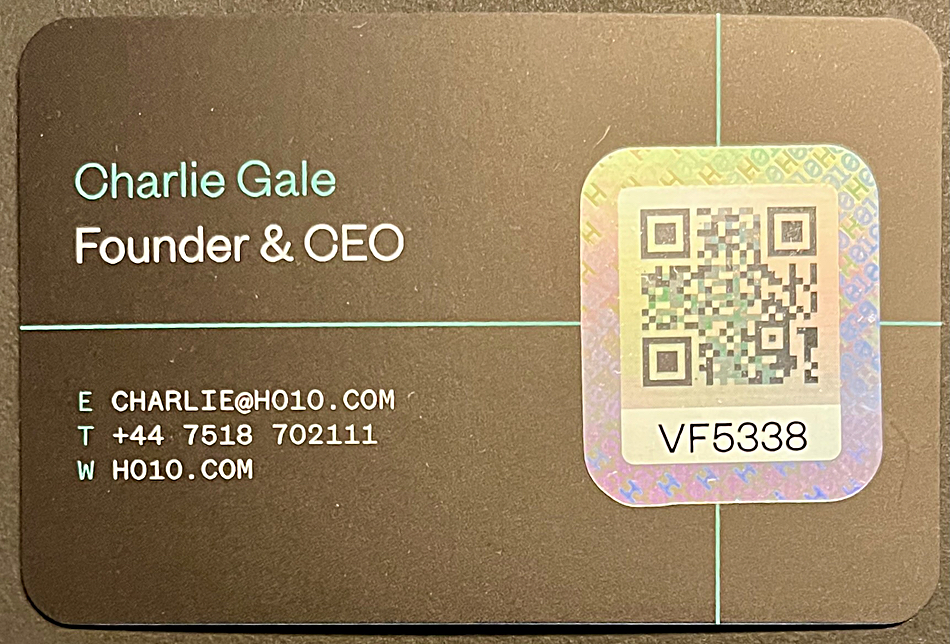
This idea led to a multi-layer, machine-readable, smartphone-authenticated, hologram, which resulted in a technology called H010, a multiplex QR code. It uses holographic technologies to have two QR codes in one image. Gale said: “You hold it up to your (smartphone) camera. It’ll say this is a HO1O label … and it will scan the multiple QR codes in it and verify them.” Three patents were granted for this while he was at Dyson.
Interestingly, the patented device could have covert layers, using invisible wavelengths of light, such as infrared, which would reveal different holograms. There is a multi-channel idea here, with one multi-plexed data source being readable via multiple channels at the same time. Hold this thought.
Gale says the thinking moved on during the COVID lockdown period to “making layers of hologram images in some substrate.” He explains, “What we originally did at HO1O for prototypes was to use a light-sensitive polymer material that you just exposed to laser light and, a bit like old-school camera film, whatever you expose it to, it locks polymer change and retains that image. This is an internal polymer change. It’s in the emulsion.”
The laser was shone on the polymer as a flood through a stencil; a very slow procedure in data storage terms.
Gale said: “How many layers do we think we could add to them? Because surely, at some stage, we’ll get to an incredibly high-fidelity, data storage system rather than a smartphone scannable security label. … So the concept of HoloMem was formed in that moment and our question was, how small and how fast do we think we can start writing holograms?”
He didn’t need a high-energy laser to ablate (erode) a resistant ceramic surface like Cerabyte or Micosoft’s Project Silica, although Gale observed, “Silica is cool. I guess they are went to very, very high-power lasers. I think it’s actually three orders of magnitude difference on the pulse energy that we’re talking about.”
Instead, he said, “We have this light-sensitive polymer material that is essentially thirsty for light, and as soon as it sees it, it uses that as the catalyst to state-change internally. And we bought $5 pulse laser diodes and we blitzed it at the polymer, making very small voxels. It recorded a string of holographic microdots that we etched originally micro QR codes into.
“We kind of viewed it as a bit like a microfiche kind of World War II microdots stuff. … we wrote that string and then we used a small camera sensor to photograph those QR codes, scan them and give back the file.”
That was the birth moment of HoloMem. Gale and his team thought they could become experts in making multi-layer machine-readable data sets without crosstalk.
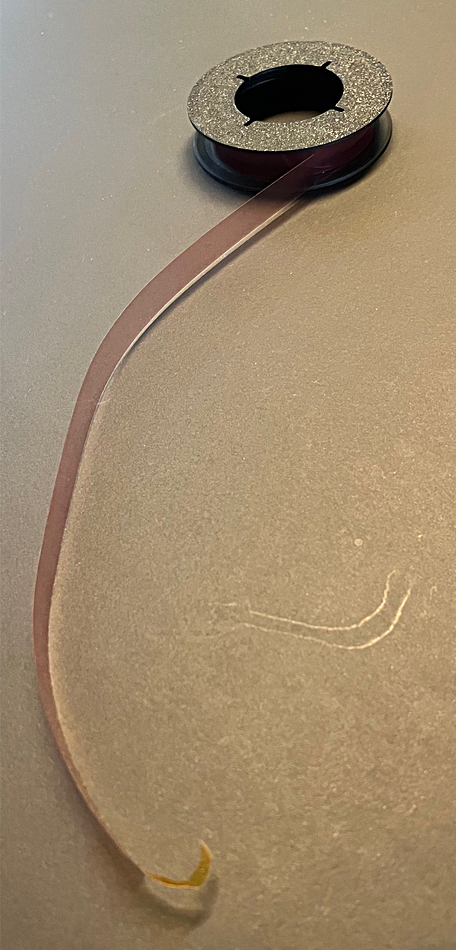
The polymer was relatively cheap: “This light-sensitive poly is developed for the automotive industry to go into windscreen to the head-up displays. You can buy it by the tub and it costs buttons.” He said “Polymer itself is like a sticky jammy material. It needs to be laminated in a sandwich.” There is a16 micron thick polymer layer between two PET laminations, giving a 120 micron thick ribbon of polymer+PET tape.
The team thought they could get to a higher volumetric density than incumbent tape.
So, we asked, how many layers are possible?
Gale answered: “The question is theoretically how many layers and practically how many layers. We’ve done both. If you ask the academics we’ve got here, what is the fundamental resolution of what can be achieved in polymer? The numbers are absolutely bonkers. We’re not going to hit a glass ceiling. The challenge for us is what’s practical and buildable in a simple device?”
So, how many layers are practical?
Gale said, “Actually it doesn’t quite work like that. Have you heard of a Fourier transform?” [See bootnote.]
In effect, the holograms overlap. “It’s actually really good for us because what you don’t want to do with any optical technology is have black and white on the surface, because high contrast is hard. You want to achieve high contrast at depth. … [If you] actually focus through the film you get a sharp image at a focal point.”
So how do you get to a precise depth to read or to write data? Gale answered, “You control the focal point” and, for that: “We actually have a 3D-printed polymer lens now.”
We asked: “You didn’t have to manipulate a physical mirror?”
Gale replied: “No, were using a DMD (Digital Mirror Device). They’re in projectors and, for want of a better definition, laser light is a tube of light. We bounce it off the DMD, where it uses the mirror to decide ‘is that pixel on or off?’”
“You get a super high contrast binary outcome. We then send that now-pregnant beam with ons and offs through our optical system to demagnify it and focus it through the film to a focal point that we want to expose that image. And the polymer just sips that up and goes, fantastic. I will lock that into my polymer change. And then that voxel or micro hologram is recorded.”
It’s a instant writing process, so fast that the moving ribbon’s motion is irrelevant, Gale explained. “We are writing data pages of thousands of bits and we’re writing them at a 1,000+ Hertz now.”
“And for us the game only gets better and better. The smaller we manage to make the hologram,” the less energy is needed to expose it. … “[With] lower energy, higher data density in the lab, we have beaten tape as a proof to ourselves. We can beat the volumetric data density of LTO-10. It’s done. What I want to do is execute a low-cost device that automates that process.”
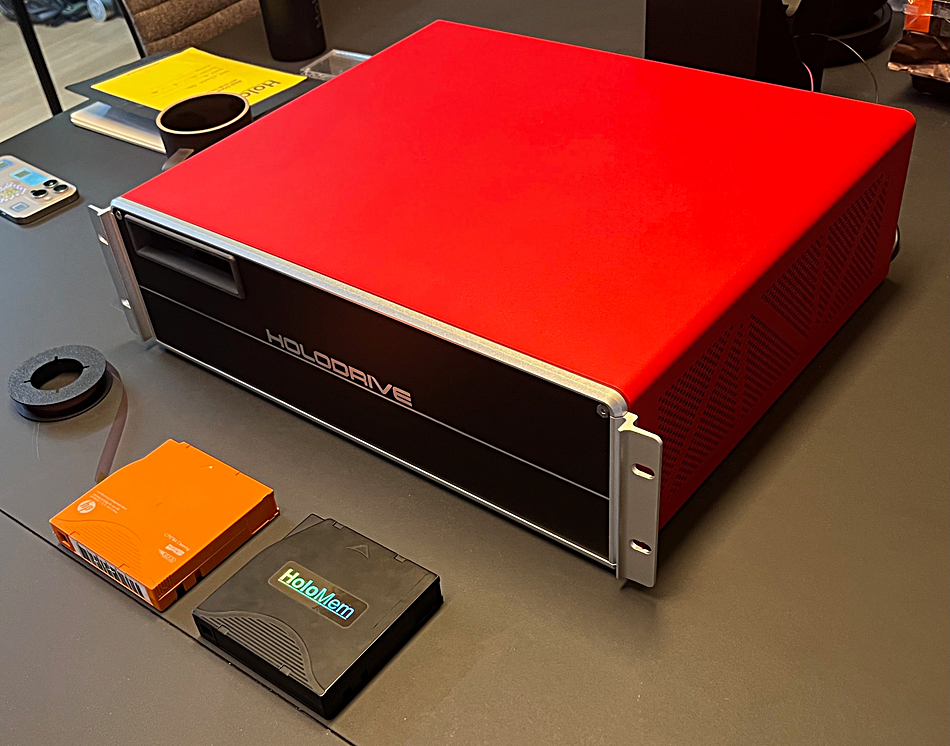
The HoloDrive is a step on that road, with Gale calling it a HO1O drive beta. “This is a very Dyson-style, get-it-done prototype. This writes and reads holographic data from our cartridge, which is … an LTO cartridge that we have put our film into.”
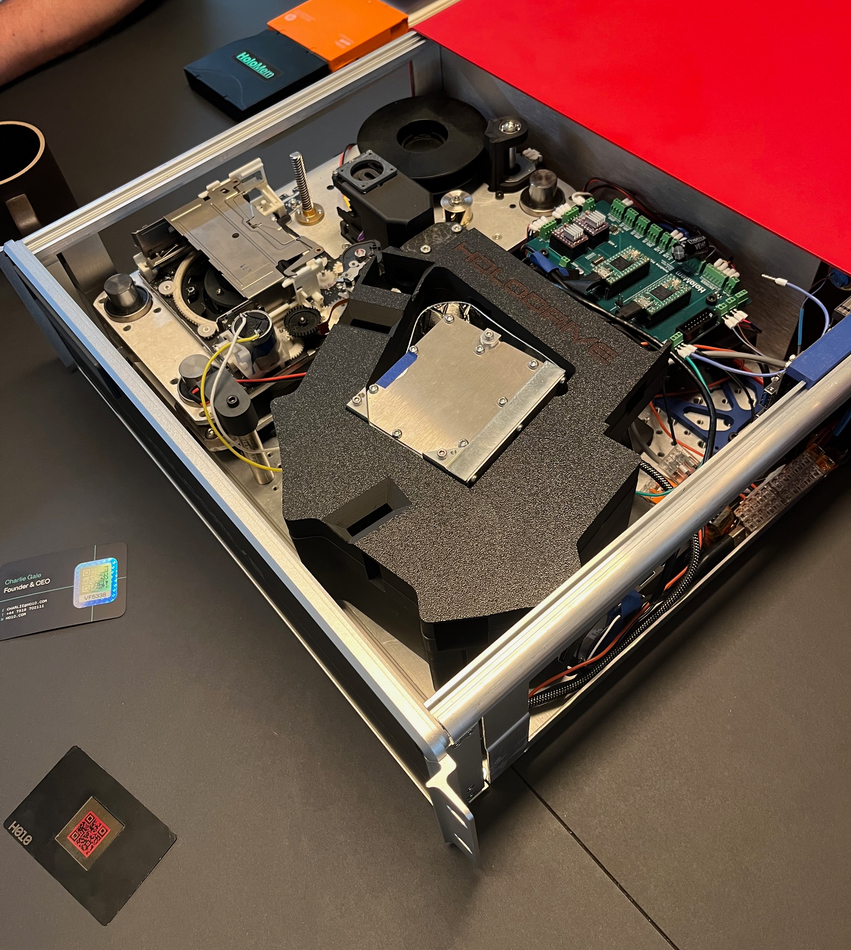
It has a combined read and write station (inside the dark grey 3D-printed structure in the image above). There are £30 prototype circuit boards and a “a cut and shut LTO loading mechanism.”
Gale says, “What this device isn’t is a world-achieving data density. We have intentionally de-tuned this system because we want it to be robust and reliable.” It generally operates at LTO-9 speed. There is no damage to the tape with repeated read: “It does not degrade the data set. There’s no such thing as data rot with this.”
The ribbon is robust, he says. “It’s spec’d for minus 40 to plus 160 degrees.” And it’s immune to electro-magnetic pulses, which could be interesting for defence-related archival storage.
He thinks tape is facing a somewhat dead end; it’s moribund so to speak. “What I think we’re trying to do here is demonstrate that there’s another angle of attack. We believe in photonic data storage. I think lots of people agree that’s kind of where things are going to go. But we’re coming at it from a another angle.” And: “The royal flush is CAPEX. This is a cheaper solution.”
He wants “to help people change their of holographic data storage,” because there is a perception of it being a failed archival storage technology.
So why put their recording medium in a tape format? Why not on a disk? “I’m not sure we can get to the volumetric data density of the hard disc drive. The aerial density of hard drives is actually really high,” Gale explained. “They’re like 500 gigabits per square inch on a half disc drive platter. Whereas LTO-10 is like 12 to 14.”
He said, “The feeling for us was the low hanging fruit is to disrupt LTO. And I think we can present a compelling comparison. We started when it was LTO-9. The fact that LTO-10 is out now doesn’t scare us a bit really.” It’s just twice the density of LTO-9 and the read speed hasn’t changed. Also the tape is fragile at 5.4 microns thick: ”The material’s so thin and so delicate now … so fragile, and over life it will stretch.”
HoloMem’s thinking is different. “It would be better to have a thicker photo polymer that you can put a lot more aerial density into, because then the mechanical challenge and the time to first byte is so much better. We probably only want to put a hundred meters of tape in our reels because then we say, we’ve got a 10th of the time to your first byte. But we can still put more data per cartridge in than they can with tape.”
Gale said, “ I think we can make a better drive. Call us LTO- 15, whatever. We make a better, higher density, longer life, more robust version of an LTO drive and cassette.”
IP protection
Gale: “We’re protected with four patents to date, primarily optical engine. How you make a high-fidelity storage and read system, holographic media handling, the cartridge of light-sensitive polymer, just the physical formatting of that.”
“We have also protected the storage of holographic data sets in a light sensing polymer that is thinner than at one millimetre.”
Funding
HoloMem has no VC funding and operates on a comparative shoestring compared with VC-backed startup standards. It received a £350,000 ($472,000) grant from the UK REsearch and Innovation fund in March 2023 to help it “optimise data storage densities, reduce noise/interference and identify the most efficient combination of laser intensity and exposure length to optimise for low-energy data recording and image clarity.”
It was awarded a £550,000 ($742,000) Smart Grant by Innovate UK for its HoloDrive project, in partnership with TechRe, the data centre consultants, in June. That’s £900,000 ($ 1.2 million) in grants and there are angel investors as well. We could view this as seed-type funding.
We understand TechRe will deploy prototype Holodrives inside LTO libraries in its UK data centers to test out the product’s performance, reliability and robustness. HoloMem has written device firmware so that, we understand, it presents itself as a kind of LTO drive.
Partnership
HoloMem joined the Digital Preservation Coalition (DPC) in May this year.
It is partnering with Qstar, which will involve QStar integrating its Archive Manager (single server) and Global ArchiveSpace (multi-server) products with HoloMem drives and media to allow prospective customers to test early release product in their own environments. HoloMem’s plug-and-play system has been designed to integrate with legacy systems with minimal hardware or software disruption.
In our view, it would be a decent idea for HoloMem to consider building a relationship with BDT, the Germany-based manufacturer of tape automation products for customers such as IBM and Spectra Logic. A library rack shelf-level item, slotted in alongside LTO drives with no upstream SW changes, would be a great way to introduce Holodrive technology in a low-friction way.
Multi-channel
A development prospect is the concept of multi-channel recording. Voxels are created at specific spectral or wavelength values. Thus, voxels created by blue light, with wavelengths between 400 and 500 nanometers, are not visible at other spectral values. Voxels created by different light spectral values, or “channels” can co-exist in the same volumetric space, and can be read at the same time and written at the same time time. Each additional channel adds to the tape’s capacity, wth two channels doubling capacity, three tripling it, and so on. This multi-channel technique could be applied to existing HoloMem ribbon media with no change; backwards-compatibility with a vengeance.
It’s somewhat similar to light wavelength division multiplexing (WDM) in optical fibers.
Thank about having a software-defined capacity function whereby you start with a single channel, and then buy a license upgrade to get multiple channels with an Nx increase in cartridge capacity where N is the number of channels. How many channels? Double-digits would seem possible, although the amount of crosstalk increases as the channel number increases.
There would be no two-year wait between cartridge capacity increases as there is with LTO generations. You would buy a drive with, say, a hypothetical 20-channel capability, license one channel and then license more as needed up to 20x. If we, again hypothetically, imagine a 200TB HoloMem cartridge , that could become a 4,000 TB raw cartridge. We understand basic patents protecting this scheme have been filed.
Bootnote
Holographic storage records data as interference patterns between a signal beam (carrying data) and a reference beam in a photosensitive medium (e.g., photopolymer or photo-refractive crystal). Data is stored as holograms, which are diffraction patterns that can reconstruct the original signal when illuminated by the reference beam. Fourier transforms are used to encode data in the spatial frequency domain, enabling compact storage and efficient retrieval.
A Fourier transform converts a spatial pattern (e.g., an image of a data page) into its frequency components, which are recorded in the hologram. To do this, a lens performs an optical Fourier transform, focusing the signal beam’s light into a spatial frequency distribution at the focal plane, where the hologram is recorded. This allows data to be stored as a compact interference pattern in the frequency domain, which can be reconstructed by applying the inverse Fourier transform (optically, via a lens, or computationally).
Multilayer storage increases capacity by recording multiple holograms at different depths or spatial locations within the medium. Fourier transforms enable multiplexing techniques (e.g., angular, wavelength, or phase-code multiplexing) to selectively record and retrieve holograms without crosstalk between layers.
The Fourier plane is compact and depth-invariant, meaning the hologram’s interference pattern is relatively insensitive to small changes in depth. This allows multiple holograms to be recorded at different depths (layers) within the medium by focusing the beams at different planes.
By adjusting the focal plane of the lens, distinct layers can be created, each storing a unique hologram. The Fourier transform ensures that data is encoded efficiently in each layer.
